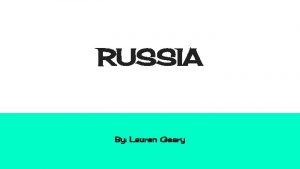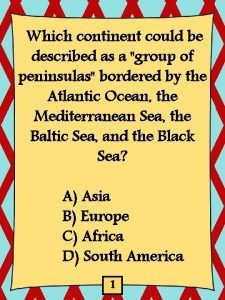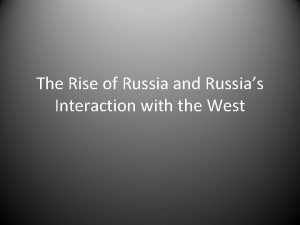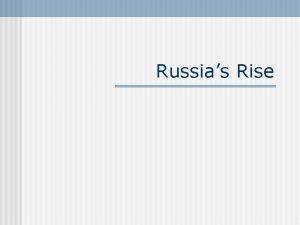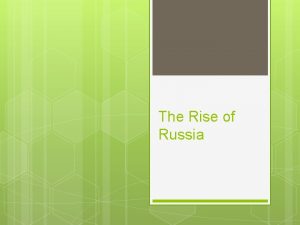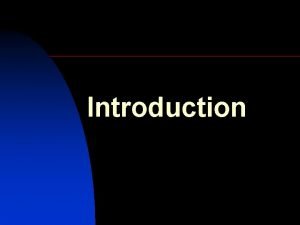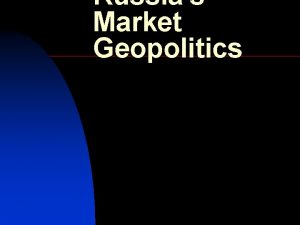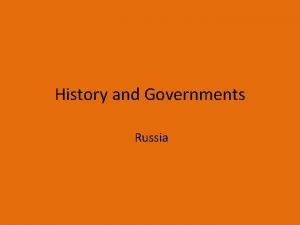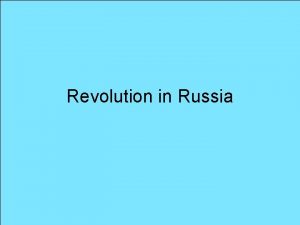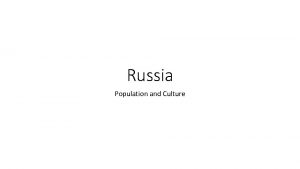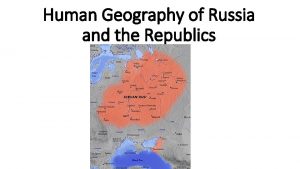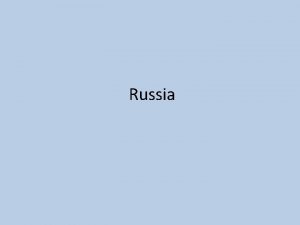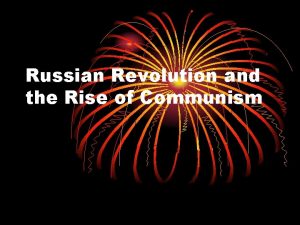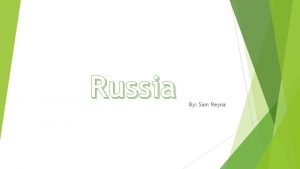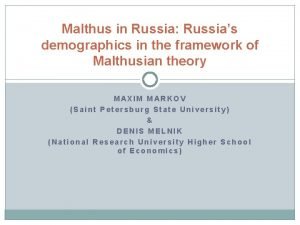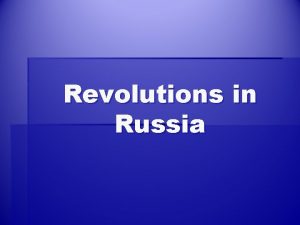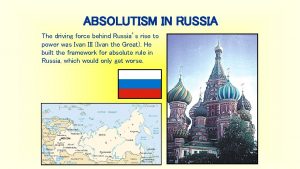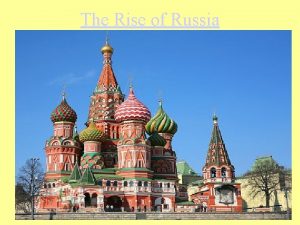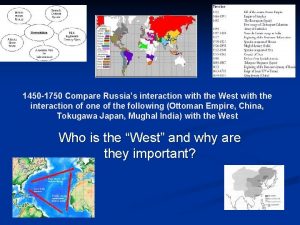The Rise of Russia and Russias Interaction with























- Slides: 23

The Rise of Russia and Russia’s Interaction with the West

I. Introduction A. Between 1450 and 1750 Russia… 1. Land based empire B. Foundation was derived from ? ? ? C. Began Selective Westernization – WHAT? ? ? 1. Emulated some Western traits 2. Remained outside of global trade system dominated by ? ? ?

II. Russia’s Expansionist Policies Under the Tsars A. Need for Revival 1. Ivan III freed much of Russia from ? ? ? a. Done by 1462 2. Even under Mongol rule, local administration ? ? ? a. Local Princes 3. Period of Mongol domination diminished ? ? ? a. Literacy and Economic Growth b. Russia remained mostly ? ? ?

II. Russia’s Expansionist Policies Under the Tsars 4. Ivan III reestablished ? ? ? 5. Ivan IV (Ivan the Terrible) a. Killed Boyars (WHO are they? ? ? ) b. WHY? ? ?


II. Russia’s Expansionist Policies Under the Tsars B. Patterns of Expansion 1. Ivans pushed WHERE ? ? ? 2. Newly conquered lands were settled by ? ? ? a. Cossacks – farmers / warriors b. Encouraged settlement of East


II. Russia’s Expansionist Policies Under the Tsars 3. Tsars rewarded loyal followers with ? ? ?

II. Russia’s Expansionist Policies Under the Tsars C. Western Contact and Romanov Policy 1. Ivan III and Ivan IV both pursued ? ? ? 2. Ivan IV died without ? ? ? a. Russia suffered a period of instability 1) Time of Troubles (1598 – 1613) b. Boyars chose Romanov dynasty to rule WHY? ? ?

II. Russia’s Expansionist Policies Under the Tsars 3. What did the Romanov’s do? ? ? a. Restored order b. Resumed policy of expansion c. Alexis Romanov 1) Tsarist autocracy WHAT IS THIS? ? ? a) Abolishes assemblies of boyars b) Takes control of Orthodox Church

III. Russia’s First Westernization (1690 -1790) A. Tsarist Autocracy of Peter the Great 1. By end of 1600 s Russia remained ? ? ? 2. Peter I (the Great) concentrated on ? ? ? a. b. c. d. e. Copying (emulation) of West WHY? ? ? Retained autocratic governmental structure BUT? ? ? Improved ? ? ? HOW? ? ? Created secret police WHY? ? ? Defeated Sweden WHY SO IMPORTANT 1) 2) Moved capital from Moscow to St. Petersburg Gave Russians warm water port (Baltic Sea)

III. Russia’s First Westernization (1690 -1790) B. What Westernization Meant for Russia 1. Peter made ? ? ? and ? ? ? more efficient HOW? ? ? a. Copied models of Western European countries 2. Economic reforms – Focused on ? ? ? 3. Cut off elites from ? ? ? a. Forced nobles to cut beards and wear Western style of clothing


Notice the changes in clothing from the traditional clothing to more Western styles

III. Russia’s First Westernization (1690 -1790) 4. Opened schools emphasizing ? ? ? and ? ? ? a. Western Intellectual Developments KEY IDEA: Changes did NOT extend to peasants or commoners 5. New manufacturing sectors and old agricultural farms continued to use ? ? ? a. Remained heavily FEUDAL b. Goal of economic development was to strengthen military – NOT become part of global trade networks

III. Russia’s First Westernization (1690 -1790) C. Consolidation Under Catherine the Great 1. Catherine seized power from her husband, Tsar Peter III HOW? ? ? a. He was disliked, inept, and some believe mildly mentally retarded b. Hated by the Russian people WHY? ? ? 2. Continued policy of ? ? ?

III. Russia’s First Westernization (1690 -1790) 3. Attempted some ? ? ? a. Friends with Enlightenment thinkers Diderot, Voltaire, and Montesquieu b. Still favored centralization and strengthened the power of the nobility over the peasants 4. Members of bureaucracy and military still came from ? ? ? 5. Landlords ? ? ? 6. What event turned Catherine against Western ideas? ? ?

IV. Themes in Early Modern Russian History A. Serfdom: The Life of Eastern Europe’s Masses 1. Unlike West, Russian economy … 2. During 17 th and 18 th centuries Russia saw ? ? ? a. Russian nobles gained ? ? ? b. Serfdom expanded to ? ? ?

IV. Themes in Early Modern Russian History 3. By 1857 – of 60. 1 million people 49. 5 million were serfs (82%) a. 50% of peasants were enserfed to nobility (agriculture) b. 50% of peasants were enserfed to state (industries) c. 1649 Act made serfdom hereditary 4. Coerced labor supported dependent agricultural economy of Russia WHY NECESSARY? ? ?

IV. Themes in Early Modern Russian History B. Trade and Economic Dependence 1. Little social stratification in Russia WHAT? ? ? a. Nobility and Serfs – very few other classes PROBLEMS? ? b. State took control of ? ? ? 1) 2) International trade controlled by ? ? ? Trade run mostly out of St. Petersburg


IV. Themes in Early Modern Russian History 2. Economy strong enough to support: a. ? ? ? b. ? ? ? c. ? ? ? 3. BUT – Agricultural and industrial production… C. Social Unrest 1. Conditions created ? ? ? 2. Peasants ? ? ? a. Frequent Uprisings

IV. Themes in Early Modern Russian History 3. Total dependence on serfdom as source of labor LED TO… a. Inflexible economy that ? ? ?
 Tricky dicky richard nixon
Tricky dicky richard nixon What is russias capital
What is russias capital Rise and rise again until lambs become lions
Rise and rise again until lambs become lions Rise and rise again until lambs become lions
Rise and rise again until lambs become lions Rise and rise again until lambs become lions origin
Rise and rise again until lambs become lions origin Which letter represents the pyrenees mountains on the map
Which letter represents the pyrenees mountains on the map Hình ảnh bộ gõ cơ thể búng tay
Hình ảnh bộ gõ cơ thể búng tay Frameset trong html5
Frameset trong html5 Bổ thể
Bổ thể Tỉ lệ cơ thể trẻ em
Tỉ lệ cơ thể trẻ em Gấu đi như thế nào
Gấu đi như thế nào Tư thế worm breton
Tư thế worm breton Bài hát chúa yêu trần thế alleluia
Bài hát chúa yêu trần thế alleluia Môn thể thao bắt đầu bằng chữ f
Môn thể thao bắt đầu bằng chữ f Thế nào là hệ số cao nhất
Thế nào là hệ số cao nhất Các châu lục và đại dương trên thế giới
Các châu lục và đại dương trên thế giới Công thức tính thế năng
Công thức tính thế năng Trời xanh đây là của chúng ta thể thơ
Trời xanh đây là của chúng ta thể thơ Mật thư anh em như thể tay chân
Mật thư anh em như thể tay chân Phép trừ bù
Phép trừ bù Phản ứng thế ankan
Phản ứng thế ankan Các châu lục và đại dương trên thế giới
Các châu lục và đại dương trên thế giới Thể thơ truyền thống
Thể thơ truyền thống Quá trình desamine hóa có thể tạo ra
Quá trình desamine hóa có thể tạo ra

